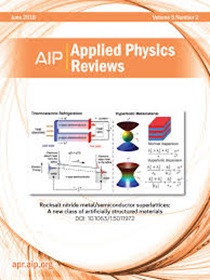光学声子对先进材料热传导的影响
IF 11.6
1区 物理与天体物理
Q1 PHYSICS, APPLIED
引用次数: 0
摘要
功率半导体和热传感器等电子器件对高性能、可靠性和寿命的要求使得有效的热管理成为一项艰巨的挑战。因此,理解晶格动力学对于调节热传导是至关重要的,因为固有极限主要取决于声子色散。传统上,热传导是通过携带热量的声子操纵来调节的,因为它们具有高的群速度,广泛应用于热涂层和热电材料中。近年来,随着热输运研究的进展,光学声子在调节热传导方面受到了极大的关注,特别是那些具有特殊色散行为的光学声子;然而,微观机制却有显著的不同。本文旨在全面了解光学声子,特别是那些具有高质量的光学声子对先进材料热传导的影响,并讨论其基本机制,包括(i)声子带宽,(ii)声子间隙,(iii)避免交叉,(iv)声子嵌套/孪晶,(v)光声声子束,以及(vi)多光学声子。本文章由计算机程序翻译,如有差异,请以英文原文为准。
Optical phonons on thermal conduction in advanced materials
The requirements for high performance, reliability, and longevity in electronic devices, such as power semiconductors and thermal sensors, make effective thermal management a formidable challenge. Thus, understanding lattice dynamics is crucial for regulating thermal conduction, as the intrinsic limit mainly depends on phonon dispersions. Conventionally, thermal conduction is regulated through heat-carrying acoustic phonon manipulation due to their high group velocities, which are widely utilized in materials such as thermal coatings and thermoelectrics. In recent years, with advancements in thermal transport, optical phonons have been of great interest for tuning thermal conduction, with a particular focus on those with special dispersive behaviors; however, the microscopic mechanisms are significantly different. This review aims to provide a comprehensive understanding of the effect of optical phonons, especially those with high weights on thermal conduction in advanced materials, as well as discuss the fundamental mechanisms, including (i) phonon bandwidth, (ii) phonon gap, (iii) avoided-crossing, (iv) phonon nesting/twinning, (v) optical-acoustic phonon bunching, and (vi) multiple optical phonons.
求助全文
通过发布文献求助,成功后即可免费获取论文全文。
去求助
来源期刊

Applied physics reviews
PHYSICS, APPLIED-
CiteScore
22.50
自引率
2.00%
发文量
113
审稿时长
2 months
期刊介绍:
Applied Physics Reviews (APR) is a journal featuring articles on critical topics in experimental or theoretical research in applied physics and applications of physics to other scientific and engineering branches. The publication includes two main types of articles:
Original Research: These articles report on high-quality, novel research studies that are of significant interest to the applied physics community.
Reviews: Review articles in APR can either be authoritative and comprehensive assessments of established areas of applied physics or short, timely reviews of recent advances in established fields or emerging areas of applied physics.
 求助内容:
求助内容: 应助结果提醒方式:
应助结果提醒方式:


